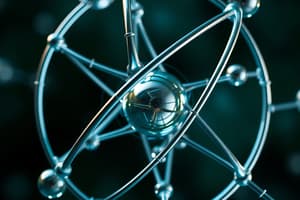Podcast
Questions and Answers
What subatomic particles are represented by $p^+$, $n_o$, and $e^-$?
What subatomic particles are represented by $p^+$, $n_o$, and $e^-$?
- Positron, neutrino, electron
- Positron, neutron, electron
- Proton, neutron, electron (correct)
- Proton, neutrino, electron
Which group of elements is known as the alkali metals?
Which group of elements is known as the alkali metals?
- Group 17
- Group 1 (correct)
- Group 2
- Group 18
What is the maximum number of electrons that can occupy the energy level when n = 1?
What is the maximum number of electrons that can occupy the energy level when n = 1?
- 18
- 8
- 2 (correct)
- 1
Which of the following elements has the largest atomic radius?
Which of the following elements has the largest atomic radius?
Ions with a positive charge are known as what?
Ions with a positive charge are known as what?
A change of state is what type of change?
A change of state is what type of change?
The number of protons for a specific element will do what?
The number of protons for a specific element will do what?
How many electrons are contained in a single covalent bond?
How many electrons are contained in a single covalent bond?
Why is a carbon-hydrogen bond considered nonpolar?
Why is a carbon-hydrogen bond considered nonpolar?
When water evaporates, what type of bonds are broken?
When water evaporates, what type of bonds are broken?
What is the chemical name for the compound $CaF_2$?
What is the chemical name for the compound $CaF_2$?
In a Lewis structure, what do the dots around an atom represent?
In a Lewis structure, what do the dots around an atom represent?
Which of the following is the correct chemical formula for ethanol?
Which of the following is the correct chemical formula for ethanol?
What is the approximate bond angle around an oxygen atom in a water molecule ($H_2O$)?
What is the approximate bond angle around an oxygen atom in a water molecule ($H_2O$)?
What type of bond is formed through the sharing of electrons between atoms?
What type of bond is formed through the sharing of electrons between atoms?
What is a common type of intermolecular force (IMF)?
What is a common type of intermolecular force (IMF)?
What does the law of conservation of mass state?
What does the law of conservation of mass state?
What does the symbol Δ above an arrow in a chemical reaction typically indicate?
What does the symbol Δ above an arrow in a chemical reaction typically indicate?
In a balanced chemical equation, what do the coefficients represent?
In a balanced chemical equation, what do the coefficients represent?
What is the correct name for the acid formed from the anion bromide ($Br^−$)?
What is the correct name for the acid formed from the anion bromide ($Br^−$)?
Flashcards
What is the name of $CaF_2$?
What is the name of $CaF_2$?
Calcium Fluoride
What is the name of $Fe_2O_3$?
What is the name of $Fe_2O_3$?
Iron(III) Oxide
What is the name of $Na_2SO_4$?
What is the name of $Na_2SO_4$?
Sodium Sulfate
What are bonded pairs?
What are bonded pairs?
Signup and view all the flashcards
What are lone pairs?
What are lone pairs?
Signup and view all the flashcards
What are alkali metals?
What are alkali metals?
Signup and view all the flashcards
What are alkaline earth metals?
What are alkaline earth metals?
Signup and view all the flashcards
What is a cation?
What is a cation?
Signup and view all the flashcards
How does nuclear strength change across a period?
How does nuclear strength change across a period?
Signup and view all the flashcards
What is an anion?
What is an anion?
Signup and view all the flashcards
Specific Gravity
Specific Gravity
Signup and view all the flashcards
Proton Number Change
Proton Number Change
Signup and view all the flashcards
Covalent Bond Electron Count
Covalent Bond Electron Count
Signup and view all the flashcards
Types of IMFs
Types of IMFs
Signup and view all the flashcards
Endothermic Physical Changes
Endothermic Physical Changes
Signup and view all the flashcards
What are Intermolecular forces (IMF)?
What are Intermolecular forces (IMF)?
Signup and view all the flashcards
Law of conservation of mass?
Law of conservation of mass?
Signup and view all the flashcards
What does 'Δ' mean in a reaction?
What does 'Δ' mean in a reaction?
Signup and view all the flashcards
Coefficients: grams or moles?
Coefficients: grams or moles?
Signup and view all the flashcards
Oxidation vs. Reduction
Oxidation vs. Reduction
Signup and view all the flashcards




